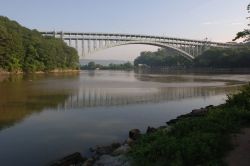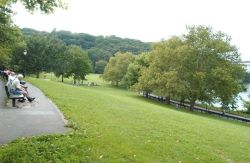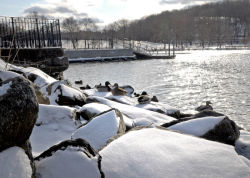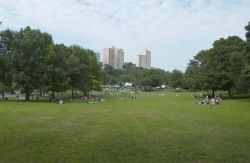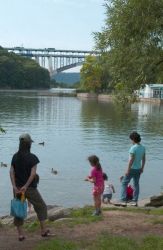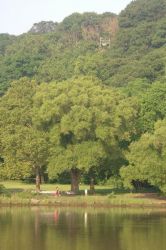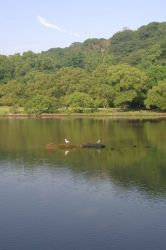Inwood Hill Park
Indian Road Playground
This playground takes its name from the road that bounds it to the north. Formerly known as Isham Avenue to honor local landowner William B. Isham, Indian Road earned its present name in 1911, when traces of an Indian settlement were found in what is now Inwood Hill Park.
Indian Road was a trail used by the Rechgawawanc clan of the Weekquaeskeek tribe of American Indians. They traveled from upstate locales to the city in order to trade furs with the European settlers during the 17th century. The road may have connected to the Spuyten Duyvil Creek, facilitating trade between the settlers of the Harlem and the Hudson River banks.
Using artifacts recovered in the late 19th and early 20th century, archaeologists date human settlement in Inwood Hill Park to prehistoric times. Local historian William L. Calver first discovered Native American tools and middens (heaps of shell and refuse) in Inwood Hill Park in the 1890s. In 1895, Alexander Chenowith uncovered caves in the park that had once served as dwellings, evidenced by pottery and carbonized food found under beds of ash. While the land was being considered for a possible park site, Reginald Pelham Bolton began extensive research on the Native American life in the area. Alanson Skinner continued the project in the 1920s. In recent years, the artifacts that had been unearthed in Inwood Hill were put on display in the Museum of the American Indian in downtown Manhattan.
Although the majority of the native population left the area by 1715, several of these native New Yorkers continued to live in the Inwood Hill area until the 1930s when Parks Commissioner Robert Moses (1888-1981), using Works Progress Administration (WPA) money and workers, initiated a massive reconstruction of the park. Parks created this playground bordering the 35-acre lawn that dominates the southeast portion of the park, which provides recreational facilities such as baseball fields with bleachers, walking paths, and picnic areas.
In 1983, parents formed “The Friends of the Indian Road Playground” (“FIRP”) to revitalize the playground. They lobbied to have fences fixed, old and unsafe equipment replaced, new rubber matting installed. They also fundraised to buy Long Island Beach sand for the sandbox.
Anna Werner was FIRP’s president. Her indefatigable efforts included soliciting new family volunteers, writing grant proposals, joining the Environmental Committee of Community Board 12, and organizing “clean-up, paint-up” parties. Members and children presented a 3-D model of their ideas for the playground’s transformation to the City Council. Funding was generously donated by the Heckscher Foundation. Although it took nearly a decade and a lot of work, the new Indian Road Playground opened in 1991.
Thanks to the founding members of Friends of the Indian Road Playground, Indian Road Playground provides an opportunity for organized play beside the wilderness of Inwood Hill Park. It is designed in a unique “chess and checker” theme, with spray showers that resemble pawns and a checker board painted on the pavement. Other features include swings and play equipment, safety surfacing, and a wooden climbing structure. Friends of Indian Road Playground continues to help Parks keep the playground safe and attractive through fundraisers and plantings.
Check out your park's Vital Signs
Clean & Safe
Green & Resilient
Empowered & Engaged Users
Share your feedback or learn more about how this park is part of a
Vital Park System

Know Before You Go


